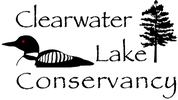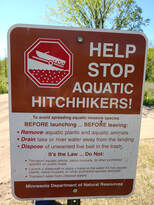
Image from 2021 University of MN AIS Detectors Guide
|

Image from 2021 University of MN AIS Detectors Guide
|
What is Eurasian Milfoil
Eurasian watermilfoil (Myriophyllum spicatum) is a feathery underwater foliage. It was once commonly sold as an aquarium plant. It originates from Europe and Asia, but was introduced to North America many years ago and is now found over much of the United States. This plant was introduced to the eastern United States at least as long ago as the 1940s, but it may have arrived as early as the late 1800s.
 Photo by Gary Perkins
Photo by Gary Perkins
Eurasian Milfoil thrives in nutrient-rich lakes. It grows earlier in the spring then most native vegetation. As it matures through the summer, it can form thick underwater mats of vegetation that float at the water's surface. It can grows in up to 20 feet of water, forming dense mats in areas of water 15 feet or less. These mats interfere with water recreation such as boating, fishing, and swimming. The plant's floating canopy can also crowd out important native water plants. With the loss of native plants the fish ecosystem is greatly affected.
Eurasian Milfoil spreads easily through stem fragmentation and runners. A single segment of stem and leaves can take root and form a new colony. In the late summer and fall the plants become brittle and naturally break apart. These fragments will float to other areas, sink, and start new plants. Milfoil will also grow from fragments created by boaters or other disturbances during any time of year. A new plant can start from a tiny piece of a milfoil plant. This is why milfoil can so easily be transported from lake to lake on boat trailers or fishing gear.
Eurasian Milfoil spreads easily through stem fragmentation and runners. A single segment of stem and leaves can take root and form a new colony. In the late summer and fall the plants become brittle and naturally break apart. These fragments will float to other areas, sink, and start new plants. Milfoil will also grow from fragments created by boaters or other disturbances during any time of year. A new plant can start from a tiny piece of a milfoil plant. This is why milfoil can so easily be transported from lake to lake on boat trailers or fishing gear.
How to Identify it
Here are some tips to identify Eurasian Milfoil from the native milfoils.
- Count the pairs of leaflets. Eurasian Milfoil usually has twelve or more pairs on each leaf. Northern Milfoil, a native plant that looks very similar has less then 20 pairs.
- Eurasian Milfoil leaves tend to collapse around the stem when removed from the water. Other milfoil species have thicker stems and are usually more robust.
- The mature leaves are typically arranged in whorls of four around the stem.
The MN DNR has created a Reference Card that you can print out and have on your boat to identify Northern VS Eurasian Milfoil.
What Can I do
Every lake user is a part of our Lake Management Team. Since Eurasian Milfoil spreads so easily it is important to always be conscious of any fragments.
- Follow the DNR recommendations listed on What Can I do and encourage other lake user to as well.
- Frequently clear your motor and anchors of all weeds. If there is any doubt, do not throw them back into the lake. Let them dry in your boat until you can transfer them to the shore. If you leave them on the shore to dry out and die, make it away from the water. We do not want the rain to wash them back into the lake.
- If you see milfoil floating, grab it to throw away. Don't leave it to float to your neighbors shore.
- Give permission to treat your shoreline or hand pull along your shore. Hand pulling is not as easy as it sounds. But it is a chemical free option and the preferred method in reed beds.
Consider a donation to the Invasive species fund, to treat our lake.
Hand Pulling
Hand pulling also requires a permit from the DNR expect in the cases listed below.
During hand pulling, operators manually remove milfoil plants from the lake bottom, taking care to remove the entire root crown and not to create fragments. It generally takes divers to reach and remove plants in deep water. During hand pulling, the divers dig around and beneath the plant roots with their hands or with a tool and gently lift the entire plant out of the sediment. It is important to remove the root crown (the fleshy, fibrous roots at the base of the stem). If it is not removed, the plant will grow back.
Since the plant becomes more brittle in the fall, earlier in the year is better for hand pulling.
There is a good description of the process by a diver at In a Diver's Own Words
Here is a video on how to hand pull Manual removal of Eurasian watermilfoil
When a permit is NOT needed from the DNR
If you are a lakeshore property owner who wants to create or maintain a swimming or boat-docking area, you may cut or pull submerged vegetation, such as Elodea, without a DNR permit under certain conditions:
In floating-leaf vegetation a lake shore property owner may maintain a channel 15 foot wide extending to open water by mechanical means without a permit. Any other destruction of floating-leaf vegetation requires a permit. If you have questions on control activities that do not require a permit, please contact your local aquatic plant specialist .
If you plan to dispose of the aquatic vegetation someplace other than on your property you will need to download the aquatic plant transport authorization form. This form allows you to transport the aquatic vegetation to a suitable location for disposal.
A DNR permit is not needed to gather aquatic plants for personal use (except for wild rice) or for constructing a shooting or observation blind.
- First, the area to be cleared must be no larger than 2,500 square feet.
- Second, the cleared area must not extend more than 50 feet along the shoreline or one-half the length of your shoreline, whichever is less.
In floating-leaf vegetation a lake shore property owner may maintain a channel 15 foot wide extending to open water by mechanical means without a permit. Any other destruction of floating-leaf vegetation requires a permit. If you have questions on control activities that do not require a permit, please contact your local aquatic plant specialist .
If you plan to dispose of the aquatic vegetation someplace other than on your property you will need to download the aquatic plant transport authorization form. This form allows you to transport the aquatic vegetation to a suitable location for disposal.
A DNR permit is not needed to gather aquatic plants for personal use (except for wild rice) or for constructing a shooting or observation blind.


